Chunyang Xiao
Automatic Labelling with Open-source LLMs using Dynamic Label Schema Integration
Jan 21, 2025Abstract:Acquiring labelled training data remains a costly task in real world machine learning projects to meet quantity and quality requirements. Recently Large Language Models (LLMs), notably GPT-4, have shown great promises in labelling data with high accuracy. However, privacy and cost concerns prevent the ubiquitous use of GPT-4. In this work, we explore effectively leveraging open-source models for automatic labelling. We identify integrating label schema as a promising technology but found that naively using the label description for classification leads to poor performance on high cardinality tasks. To address this, we propose Retrieval Augmented Classification (RAC) for which LLM performs inferences for one label at a time using corresponding label schema; we start with the most related label and iterates until a label is chosen by the LLM. We show that our method, which dynamically integrates label description, leads to performance improvements in labelling tasks. We further show that by focusing only on the most promising labels, RAC can trade off between label quality and coverage - a property we leverage to automatically label our internal datasets.
Forgetting Curve: A Reliable Method for Evaluating Memorization Capability for Long-context Models
Oct 07, 2024



Abstract:Numerous recent works target to extend effective context length for language models and various methods, tasks and benchmarks exist to measure model's effective memorization length. However, through thorough investigations, we find limitations for currently existing evaluations on model's memorization capability. We provide an extensive survey for limitations in this work and propose a new method called forgetting curve to measure the memorization capability of long-context models. We show that forgetting curve has the advantage of being robust to the tested corpus and the experimental settings, of not relying on prompts and can be applied to any model size. We apply our forgetting curve to a large variety of models involving both transformer and RNN/SSM based architectures. Our measurement provides empirical evidence for the effectiveness of transformer extension techniques while raises questions for the effective length of RNN/SSM based models. We also examine the difference between our measurement and existing benchmarks as well as popular metrics for various models. Our code and results can be found at https://github.com/1azybug/ForgettingCurve.
More Effective LLM Compressed Tokens with Uniformly Spread Position Identifiers and Compression Loss
Sep 22, 2024



Abstract:Compressing Transformer inputs into compressd tokens allows running LLMs with improved speed and cost efficiency. Based on the compression method ICAE, we carefully examine the position identifier choices for compressed tokens and also propose a new compression loss. We demonstrate empirically that our proposed methods achieve significantly higher compression ratios (15x compared to 4x for ICAE), while being able to attain comparable reconstruction performance.
Translate-and-Revise: Boosting Large Language Models for Constrained Translation
Jul 18, 2024



Abstract:Imposing constraints on machine translation systems presents a challenging issue because these systems are not trained to make use of constraints in generating adequate, fluent translations. In this paper, we leverage the capabilities of large language models (LLMs) for constrained translation, given that LLMs can easily adapt to this task by taking translation instructions and constraints as prompts. However, LLMs cannot always guarantee the adequacy of translation, and, in some cases, ignore the given constraints. This is in part because LLMs might be overly confident in their predictions, overriding the influence of the constraints. To overcome this overiding behaviour, we propose to add a revision process that encourages LLMs to correct the outputs by prompting them about the constraints that have not yet been met. We evaluate our approach on four constrained translation tasks, encompassing both lexical and structural constraints in multiple constraint domains. Experiments show 15\% improvement in constraint-based translation accuracy over standard LLMs and the approach also significantly outperforms neural machine translation (NMT) state-of-the-art methods.
Towards Robust Aspect-based Sentiment Analysis through Non-counterfactual Augmentations
Jun 24, 2023Abstract:While state-of-the-art NLP models have demonstrated excellent performance for aspect based sentiment analysis (ABSA), substantial evidence has been presented on their lack of robustness. This is especially manifested as significant degradation in performance when faced with out-of-distribution data. Recent solutions that rely on counterfactually augmented datasets show promising results, but they are inherently limited because of the lack of access to explicit causal structure. In this paper, we present an alternative approach that relies on non-counterfactual data augmentation. Our proposal instead relies on using noisy, cost-efficient data augmentations that preserve semantics associated with the target aspect. Our approach then relies on modelling invariances between different versions of the data to improve robustness. A comprehensive suite of experiments shows that our proposal significantly improves upon strong pre-trained baselines on both standard and robustness-specific datasets. Our approach further establishes a new state-of-the-art on the ABSA robustness benchmark and transfers well across domains.
A call for better unit testing for invariant risk minimisation
Jun 06, 2021
Abstract:In this paper we present a controlled study on the linearized IRM framework (IRMv1) introduced in Arjovsky et al. (2020). We show that IRMv1 (and its variants) framework can be potentially unstable under small changes to the optimal regressor. This can, notably, lead to worse generalisation to new environments, even compared with ERM which converges simply to the global minimum for all training environments mixed up all together. We also highlight the isseus of scaling in the the IRMv1 setup. These observations highlight the importance of rigorous evaluation and importance of unit-testing for measuring progress towards IRM.
Grammatical Sequence Prediction for Real-Time Neural Semantic Parsing
Jul 25, 2019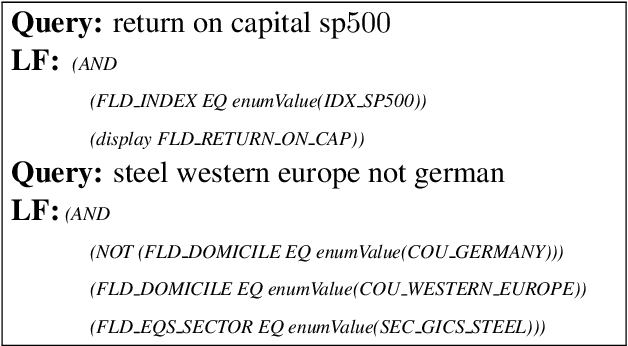
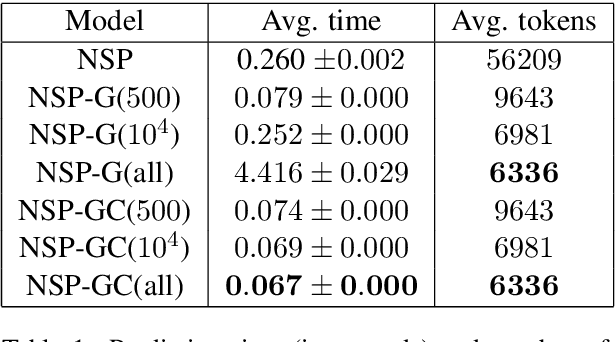
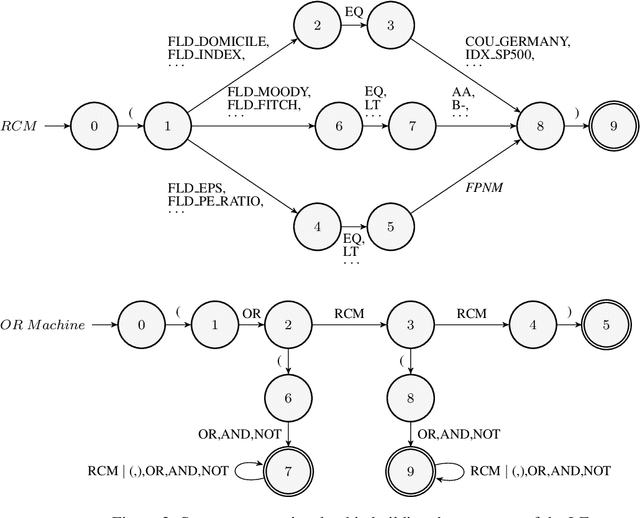

Abstract:While sequence-to-sequence (seq2seq) models achieve state-of-the-art performance in many natural language processing tasks, they can be too slow for real-time applications. One performance bottleneck is predicting the most likely next token over a large vocabulary; methods to circumvent this bottleneck are a current research topic. We focus specifically on using seq2seq models for semantic parsing, where we observe that grammars often exist which specify valid formal representations of utterance semantics. By developing a generic approach for restricting the predictions of a seq2seq model to grammatically permissible continuations, we arrive at a widely applicable technique for speeding up semantic parsing. The technique leads to a 74% speed-up on an in-house dataset with a large vocabulary, compared to the same neural model without grammatical restrictions.
Symbolic Priors for RNN-based Semantic Parsing
Sep 20, 2018
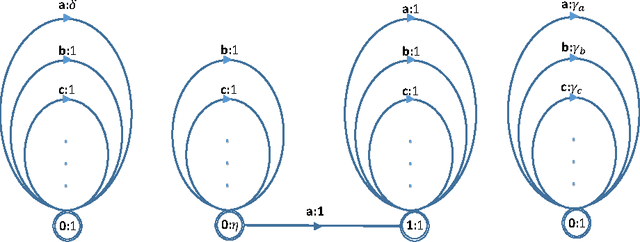

Abstract:Seq2seq models based on Recurrent Neural Networks (RNNs) have recently received a lot of attention in the domain of Semantic Parsing for Question Answering. While in principle they can be trained directly on pairs (natural language utterances, logical forms), their performance is limited by the amount of available data. To alleviate this problem, we propose to exploit various sources of prior knowledge: the well-formedness of the logical forms is modeled by a weighted context-free grammar; the likelihood that certain entities present in the input utterance are also present in the logical form is modeled by weighted finite-state automata. The grammar and automata are combined together through an efficient intersection algorithm to form a soft guide ("background") to the RNN. We test our method on an extension of the Overnight dataset and show that it not only strongly improves over an RNN baseline, but also outperforms non-RNN models based on rich sets of hand-crafted features.
Log-Linear RNNs: Towards Recurrent Neural Networks with Flexible Prior Knowledge
Dec 16, 2016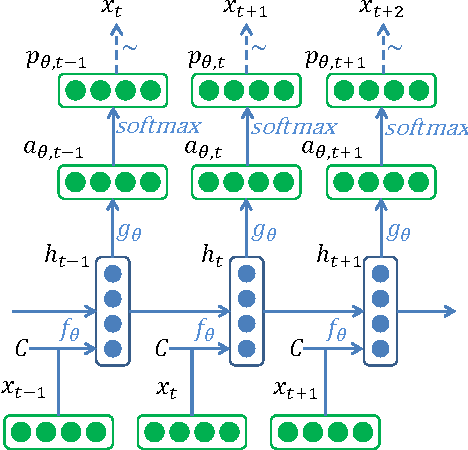

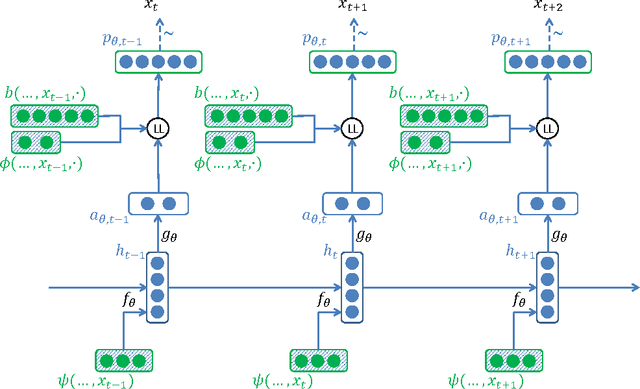

Abstract:We introduce LL-RNNs (Log-Linear RNNs), an extension of Recurrent Neural Networks that replaces the softmax output layer by a log-linear output layer, of which the softmax is a special case. This conceptually simple move has two main advantages. First, it allows the learner to combat training data sparsity by allowing it to model words (or more generally, output symbols) as complex combinations of attributes without requiring that each combination is directly observed in the training data (as the softmax does). Second, it permits the inclusion of flexible prior knowledge in the form of a priori specified modular features, where the neural network component learns to dynamically control the weights of a log-linear distribution exploiting these features. We conduct experiments in the domain of language modelling of French, that exploit morphological prior knowledge and show an important decrease in perplexity relative to a baseline RNN. We provide other motivating iillustrations, and finally argue that the log-linear and the neural-network components contribute complementary strengths to the LL-RNN: the LL aspect allows the model to incorporate rich prior knowledge, while the NN aspect, according to the "representation learning" paradigm, allows the model to discover novel combination of characteristics.
Move from Perturbed scheme to exponential weighting average
Dec 22, 2015Abstract:In an online decision problem, one makes decisions often with a pool of decision sequence called experts but without knowledge of the future. After each step, one pays a cost based on the decision and observed rate. One reasonal goal would be to perform as well as the best expert in the pool. The modern and well-known way to attain this goal is the algorithm of exponential weighting. However, recently, another algorithm called follow the perturbed leader is developed and achieved about the same performance. In our work, we first show the properties shared in common by the two algorithms which explain the similarities on the performance. Next we will show that for a specific perturbation, the two algorithms are identical. Finally, we show with some examples that follow-the-leader style algorithms extend naturally to a large class of structured online problems for which the exponential algorithms are inefficient.
 Add to Chrome
Add to Chrome Add to Firefox
Add to Firefox Add to Edge
Add to Edge